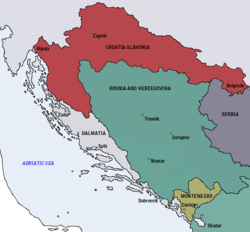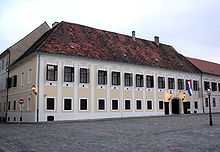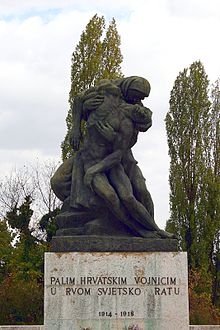- Kingdom of Croatia-Slavonia
-
Kingdom of Croatia-Slavonia
Kraljevina Hrvatska i Slavonija
Horvát-Szlavón KirályságLand of the Crown of St. Stephen
(within the Austro-Hungarian Monarchy)← 
←
1868–1918  →
→

Flag Coat of arms Anthem
Carevka
Lijepa naša domovinoMap of the Kingdom of Croatia Slavonia (red) cca. 1885. The Kingdom was a part of Transleithanian Austria-Hungary, the Kingdom of Hungary (Lands of the Crown of St. Stephen). The rest of Austria-Hungary is in light gray. Capital Zagreb Language(s) Croatian[1][2][3][4] or Croatian or Serbian,[5][6][7] Hungarian Religion Roman Catholic Government Monarchy Historical era Austria–Hungary - 1867 Compromise 29 May 1867 - Established 1868 - Joined the State of Slovenes, Croats and Serbs 29 October 1918 Area - 1910 42,541 km2 (16,425 sq mi) Population - 1880 est. 1,892,499 - 1910 est. 2,621,954 Density 61.6 /km2 (159.6 /sq mi) Currency gulden (up to 1892)
krone (from 1892)Area source:[8] Population source:[9] The Kingdom of Croatia-Slavonia or Croatia Slavonia (Croatian: Trojedna Kraljevina Hrvatska-Slavonija-Dalmacija; Hungarian: Horvát-, Szlavon- és Dalmátországok; German: Königreich Kroatien und Slawonien) was an autonomous kingdom within the Austro-Hungarian Empire. It was part of the Hungarian Kingdom within the dual Austro-Hungarian state, being within the Lands of the Crown of St. Stephen or Transleithania. The kingdom was ruled by the Habsburg King-Emperor of Austria-Hungary (Kaiser und König), under his title as King of Hungary. The monarch's title was "King of Croatia and Slavonia". The King's appointed steward was the Ban of Croatia and Slavonia.
The kingdom pressed its claim on the Kingdom of Dalmatia under the title the Triune Kingdom of Croatia, Slavonia, and Dalmatia within the Hungarian part of the monarchy, which was also a historic name for a Croatian Kingdom. Dalmatia was a Kronland within the imperial Austrian part of Austria-Hungary (also known as Cisleithania). The claim was, for most of the time, supported by the Hungarian government which backed Croatia-Slavonia in an effort to increase its share of the dual state. The union between the two primarily Croatian lands of Austria-Hungary never took place however.[10] According to the Article 53 of the Croatian–Hungarian Agreement, that governed Croatia's political status in the Hungarian-ruled part of Austria-Hungary, ban's official title was "Ban of Kingdom of Dalmatia, Croatia and Slavonia".[11][12]
Contents
History
Main article: Croatia in the Habsburg Empire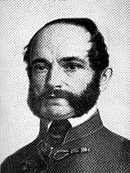 Ivan Mažuranić, Ban (viceroy) of the Kingdom of Croatia-Slavonia (in office 1873-1880)
Ivan Mažuranić, Ban (viceroy) of the Kingdom of Croatia-Slavonia (in office 1873-1880)
The Kingdom of Croatia-Slavonia was created in 1868, when the former kingdoms of Croatia and Slavonia were joined into one single kingdom. The Croatian parliament, elected in a questionable manner, confirmed the subordination of Croatia-Slavonia to Hungary in 1868 with signing of Hungarian-Croatian union constitution called the Nagodba.[13] This kingdom included parts of present-day Croatia and Serbia (eastern part of Syrmia).
After the Austro-Hungarian Compromise of 1867 the only remaining open question of the new state was the status of Croatia, which would be solved with the Hungarian-Croatian compromise of 1868 when agreement was reached between the Parliament of Hungary on one hand and the Parliament of Croatia-Slavonia on the other hand, with regard to the composition by a joint enactment of the constitutional questions at issue between them.[11]
With this compromise the parliament of personal union (in which Croatia-Slavonia had only twenty-nine deputies) controlled the military, the financial system, legislation and administration, Sea Law, Commercial Law, the law of Bills of Exchange and Mining Law, and generally matters of commerce, customs, telegraphs, Post Office, railways, harbors, shipping, and those roads and rivers which jointly concern Hungary and Croatia-Slavonia.[11]
Similarly to these affairs, trade matters including hawking, likewise with regard to societies which do not exist for public gain, and also with regard to passports, frontier police, citizenship and naturalization, the legislation was joint, but the executive in respect of these affairs was reserved to Kingdom of Croatia-Slavonia.[11] In the end, fifty-five per cent of the total income of Croatia-Slavonia were assigned to the Joint Treasury.
The Kingdom of Croatia-Slavonia held independent elections for Croatian Parliament in 1865, 1867, 1871, 1872, 1878, 1881, 1883, 1884, 1887, 1892, 1897, 1901, 1906, 1908, 1910, 1911, 1913.
The kingdom existed until 1918 when it joined the newly formed State of Slovenes, Croats and Serbs, which together with the Kingdom of Serbia formed the Kingdom of Serbs, Croats and Slovenes. The new Serb-Croat-Slovene Kingdom was divided into counties between 1918 and 1922 and into oblasts between 1922 and 1929. With the formation of the Kingdom of Yugoslavia in 1929, most of the territory of the former Kingdom of Croatia-Slavonia became a part of the Sava Banate.
Government and politics
Political status
Main article: Croatian–Hungarian AgreementThe Austro-Hungarian Compromise (Ausgleich) of 1867 created the Dual Monarchy. Under the Compromise, Austria and Hungary each had separate parliaments that passed and maintained separate laws. Each region had its own government, headed by its own prime minister. The "common monarchy" consisted of the emperor-king and the common ministers of foreign affairs, defense and finance in Vienna. The Compromise confirmed Croatia-Slavonia's historic, eight-centuries-old relationship with Hungary and perpetuated the division of the Croat lands, for both Dalmatia and Istria remained under Austrian administration.[14]
At Franz Joseph's insistence, Hungary and Croatia reached the Compromise (or Nagodba)) in 1868, giving the Croats a special status in Hungary. The agreement granted the Croats autonomy over their internal affairs. The Croatian ban would now be nominated by the Hungarian prime minister and appointed by the king. Areas of "common" concern to Hungarians and Croats included finance, currency matters, commercial policy, the post office, and the railroad. Croatian became the official language of Croatia's government, and Croatian representatives discussing "common" affairs before the Hungarian diet were permitted to speak Croatian.[15] A ministry of Croatian Affairs was created within the Hungarian government.
Although the Nagodba provided a measure of political autonomy to Croatia-Slavonia, it was subordinated politically and economically to Hungary.[14]
Autonomous Government
The Autonomous Government or Land Government (Croatian: Zemaljska vlada), established in 1868 with seat in Zagreb, until 1914 it possessed three departments:
- Department for internal affairs (Croatian: Odjela za unutarnje poslove);
- Department for religion and education (Croatian: Odjel za bogoštovlje i nastavu);
- Department for justice (Croatian: Odjel za pravosuđe).
In 1914 a fourth department was added for national economy (Croatian: Odjel za narodno gospodarstvo).[14]
At the head of the Autonomous Government in Croatia-Slavonia stood the Ban, who was responsible to the Croatian-Slavonian-Dalmatian Diet.[16]
Ban (viceroy)
Main article: Ban of CroatiaThe Ban was appointed by the King, on the proposal and under the counter-signature of the Joint Hungarian minister-president.[16]
List of bans (viceroys) from 1868 until 1918:
- Baron Levin Rauch de Nyék 1868 - 1871
- Koloman Bedeković 1871 - 1872
- Ivan Mažuranić 1873 - 1880
- Ladislav Pejačević 1880 - 1883
- Dragutin Khuen-Héderváry 1883 - 1903
- Teodor Pejačević 1903 - 1907
- Aleksandar Rakodczay 1907 - 1908
- Pavao Rauch 1908 - 1910
- Nikola Tomašić 1910 - 1912
- Slavko Cuvaj 1912 - 1913
- Ivan Skerlecz de Lomnica 1913 - 1917
- Antun Mihalović 1917 - 1918
Law
The supreme court of kingdom was the Stol sedmorice (Table of Seven), while the second-level court was the Banski stol (Ban's Table) headed by the ban.[17]
Counties
In November 1874, under Croatian ban Ivan Mažuranić, Croatia-Slavonia was divided into eight counties (known as comitatus):[18]
- Modruš-Rijeka County
- Zagreb County
- Varaždin County
- Bjelovar-Križevci County
- Virovitica County
- Požega County
- Srijem County
- Lika-Krbava County
Lika-Krbava became a county after the incorporation of the Croatian Military Frontier into Croatia-Slavonia in 1881.[18] The counties were subsequently divided into a total of 77 districts, which were then divided into okrugs and municipalities.
Symbols
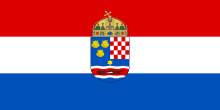 Alternate flag, used internally "for autonomic affairs" by decree of the viceroy.[19]
Alternate flag, used internally "for autonomic affairs" by decree of the viceroy.[19]
 The Coat of Arms of Croatia-Slavonia on the building of the Parliament of Croatia
The Coat of Arms of Croatia-Slavonia on the building of the Parliament of Croatia
According to the Croatian–Hungarian Agreement in 1868:
Croatia, Slavonia and Dalmatia can, within their own frontiers in their internal affairs, use their own combined colours and coat of arms, the latter, however, being surmounted by the Crown of St. Stephen.(Art. 61) The emblem of the Joint Affairs of the territories of the Hungarian Crown is formed by the combined arms of Hungary and of Croatia, Slavonia and Dalmatia. (Art. 62) At times when Joint Affairs are being debated, the combined Croatian-Slavonia-Dalmatian flag is to be hoisted beside the Hungarian flag, upon the building in which the Joint Parliament of the territories of the Hungarian Crown is being held. (Art. 63)[20][21]Demographics
Nationality
In the 1910 census, the total population numbered 2,621,954, of the following nationalities:[22]
- Croats: 1,638,354 (62.5%)
- Serbs: 644,955 (24.6%)
- Germans: 134,078 (5%)
- Hungarians: 105,948 (4.1%)
- Others: 98,619 (3.8%)
Religion
Data taken from the 1910 census.[22]
- Roman Catholic: 1,877,833
- Serbian Orthodox: 653,184
- Protestant: 51,707
- Uniate: 17,592
Literacy
In the 1910 census, the illiteracy rates were as follows:[23]
- Males: 38.2%
- Females: 53.7%
- Total: 46.2%
Military
The Croatian Home Guard was the military of the Kingdom. Notable Croatians in the Austro-Hungarian Army included Field Marshal Svetozar Boroević, commander of the Imperial and Royal Aviation Troops Emil Uzelac, and commander of the Austro-Hungarian Navy Maximilian Njegovan.
Culture
The modern University of Zagreb was founded in 1874. The Yugoslav Academy of Sciences and Arts and Matica hrvatska were the main cultural institutions in the kingdom. In 1911 the main cultural institution in the Kingdom of Dalmatia, Matica dalmatinska, marged with Matica hrvatska. Vijenac was one of the most important cultural magazines in the kingdom. The building of the Croatian National Theatre in Zagreb was opened in 1895. The Croatian National Theatre in Osijek was established in 1907. The Sisters of Charity Hospital in Zagreb was the first established in the kingdom.
Religion
Catholic Church
Roughly 75% of the population were Roman Catholic, with the remaining 25% Serbian Orthodox. The Catholic Church had the following hierarchy within the kingdom:
Dioceses Croatian name Est. Cathedral Archdiocese of Zagreb Zagrebačka nadbiskupija 1093 Zagreb Cathedral Eparchy of Križevci (Greek-Catholic) Križevačka biskupija 1777 Diocese of Srijem Srijemska biskupija 4th century Cathedral of St. Peter and St. Paul Diocese of Senj-Modruš Senjsko-modruška biskupija 1168 Judaism
In 1890, there were 17,261 Jews living in the kingdom. In 1867 the Zagreb Synagogue was built.
Transportation
History of Croatia 
This article is part of a seriesEarly history Prehistoric Croatia Origins of the Croats White Croatia Medieval history Littoral Croatia · Pannonian Croatia · Pagania · Zachlumia · Travunia Kingdom of Croatia March of Istria Republic of Poljica Republic of Dubrovnik Kingdom of Bosnia Habsburg Empire Kingdom of Croatia Croatian Military Frontier Illyrian Provinces · Kingdom of Illyria Kingdom of Slavonia Kingdom of Dalmatia Kingdom of Croatia-Slavonia State of Slovenes, Croats, and Serbs Yugoslavia Kingdom of Yugoslavia
(Banovina of Croatia)World War II
Independent State of Croatia
Federal State of CroatiaSocialist Republic of Croatia Contemporary Croatia War of independence Republic of Croatia
Croatia Portal
The first railway line opened in the kingdom was the Zidani Most-Zagreb-Sisak route which began operations in 1862. The Zaprešić-Varaždin-Čakovec line was opened in 1886 and the Vinkovci-Osijek line was opened in 1910.
Sports
The Croatian Sports Association was formed in 1909 with Franjo Bučar as its president. While Austria-Hungary had competed in the modern Olympics since the inaugural games in 1896, the Austrian Olympic Committee and Hungarian Olympic Committee held the exclusive right to send their athletes to the games. The association organized a national football league in 1912.
Legacy
In 1918, during last days of World War I, Croatian parliament abolished the Hungarian-Croatian personal union, and both parts of the Kingdom of Croatia and Slavonia and the Kingdom of Dalmatia (excluding Zadar and Lastovo), became part of the State of Slovenes, Croats and Serbs, which together with the Kingdom of Serbia, formed the Kingdom of Serbs, Croats and Slovenes (later known as the Kingdom of Yugoslavia). The new Serb-Croat-Slovene Kingdom was divided into counties between 1918 and 1922 and into oblasts between 1922 and 1929. With the formation of the Kingdom of Yugoslavia in 1929, most of the territory of the former Kingdom of Croatia-Slavonia became a part of the Sava Banovina, and most of the former Kingdom of Dalmatia became part of the Littoral Banovina.
Notes
- ^ Biondich, Mark; Stjepan Radić, the Croat Peasant Party, and the politics of mass mobilization, 1904-1928; University of Toronto Press, 2000 ISBN 0-80208-294-7, page 9
- ^ Marcus Tanner, "A nation forged in war", Yale University Press, ISBN 0-300-09125-7, page 99
- ^ According to articles 56 and 57 of Nagodba only official language in Croatia is Croatian (Po čl. 56. i 57. Hrvatsko-ugarske nagodbe u Hrvatskoj je u službenoj uporabi samo hrvatski jezik), Dragutin Pavličević, "Povijest Hrvatske", Naklada Pavičić, Zagreb, 2007, ISBN 978-953-6308-71-2, page 273
- ^ 56. In the whole territory of Croatia-Slavonia the Croatian language is the language alike of the Legislature, the Administration and the Judicature. 57. Inside the frontiers of Croatia-Slavonia the Croatian language is prescribed as the official language for the organs of the Joint Government also. http://www.h-net.org/~habsweb/sourcetexts/nagodba2.htm - online text from Robert William Seton-Watson, "The Southern Slav Question and the Habsburg Monarchy", London, Constable and Co., 1911, ISBN 0-72222-328-5, page 371
- ^ Austro-Hungarian census documents
- ^ Charles Jelavich, South Slav nationalisms - textbooks and Yugoslav Union before 1914; Ohio State University Press, 1990; pp. 171-173 ISBN 0-81420-500-3
- ^ Jelena Milojković-Djurić, The Eastern question and the voices of reason: Austria-Hungary, Russia, and the Balkan States, 1875-1908; East European Monographs, 2002; pp. 82-83 ISBN 0-88033-490-8
- ^ Rothschild, Joseph (1974). East Central Europe Between the Two World Wars (3rd ed.). Volume 9. University of Washington Press. p. 155. ISBN 0295953578.
- ^ Biondich 2000, p. 15
- ^ Ivo Goldstein, Nikolina Jovanović; Croatia: a history; C. Hurst & Co. Publishers, 1999 ISBN 1-85065-525-1
- ^ a b c d Constitution of Union between Croatia-Slavonia and Hungary
- ^ The Hungaro-Croatian Compromise (Croatian)
- ^ Britannica 2009 Nagodba
- ^ a b c Biondich 2000, p. 9
- ^ History of Hungary
- ^ a b http://www.h-net.org/~habsweb/sourcetexts/nagodba3.htm The Hungaro-Croatian Compromise of 1868 (The Nagodba), III
- ^ Hrvatska pravna povijest 1790. - 1918., Croatian Supreme Court
- ^ a b Biondich 2000, p. 11
- ^ Ban (viceroy) Iván Skerlecz: "According to the § 61 article I from the year 1868 of Agreement and of decree of the Department of Interior of the Royal Country Government of November 16th, 1867, No. 18.307, red-white-blue tricolour is civil flag in the Kingdoms of Croatia and Slavonia, which with the united Coat-of-Arms of Croatia, Slavonia and Dalmatia with the crown of saint Stephen on the top is official flag for usage in autonomic affairs. Above-mentioned civil flag may be used by everyone in appropriate way." [1] [2]
- ^ The Hungaro-Croatian Compromise of 1868 (The Nagodba), II
- ^ Croatia - Historical Flags (1848-1918), www.fotw.net
- ^ a b Seton-Watson, Hugh (1945). Eastern Europe Between the Wars, 1918–1941 (3rd ed.). CUP Archive. p. 434. ISBN 100128478X.
- ^ Biondich 2000, p. 16
References
- Biondich, Mark (2000). Stjepan Radić, the Croat Peasant Party, and the Politics of Mass Mobilization. University of Toronto Press. ISBN 0802082947.
External links
- Codex diplomaticus Regni Croatiae, Slavoniae et Dalmatiae, Internet Archive - digital library
- Euratlas Maps
- Erdélyi Magyar Adatbank Map
- Map
- Ethnic map
 Subdivisions of Austria–Hungary
Subdivisions of Austria–HungaryCisleithania Archduchy of Austria • Kingdom of Bohemia • Duchy of Bukovina • Duchy of Carinthia • Duchy of Carniola • Kingdom of Dalmatia • Kingdom of Galicia and Lodomeria • Austrian Littoral (County of Gorizia and Gradisca, Margravate of Istria) • Margraviate of Moravia • Duchy of Salzburg • Duchy of Upper and Lower Silesia • Duchy of Styria • County of TyrolTransleithania Kingdom of Hungary • Kingdom of Croatia-Slavonia • Military Frontier (until 1882)Imperial Condominium Categories:- Former monarchies of Europe
- Former countries in Europe
- States and territories established in 1868
- States and territories disestablished in 1918
- History of Croatia
- Kingdom of Croatia
- History of Slavonia
- Kingdom of Hungary
- History of Serbia
- History of Vojvodina
- Former Slavic countries
- Kingdoms and countries of Austria-Hungary
Wikimedia Foundation. 2010.

